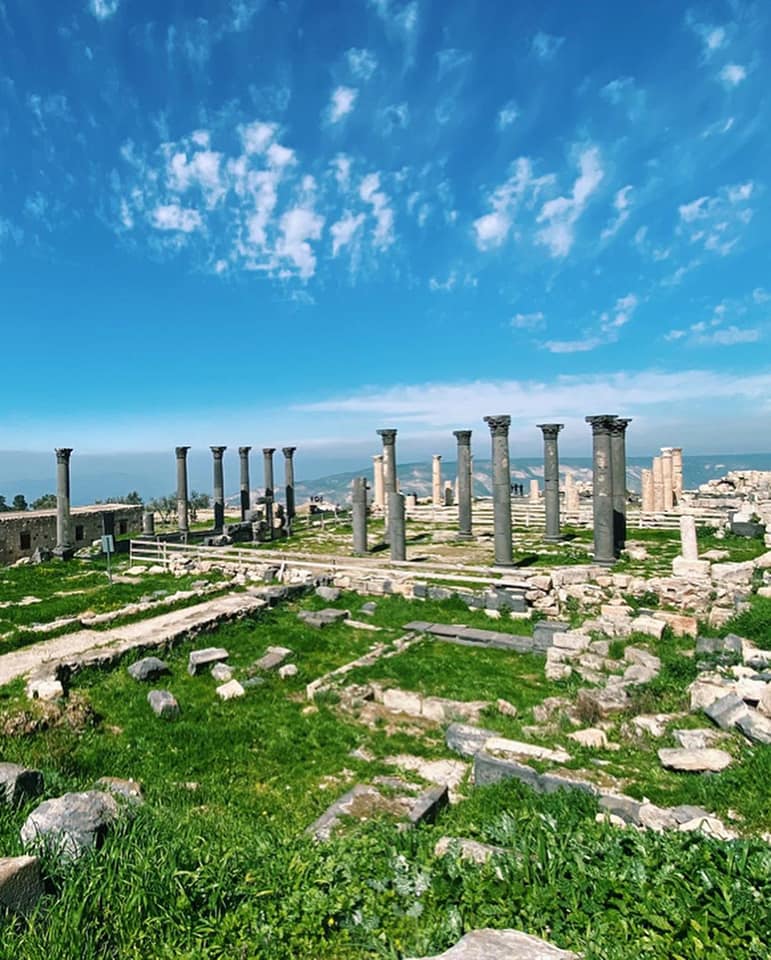Little is known of the earliest history of Gadara, a hilltop site in the north-west corner of Jordan with grand views over Lake Tiberias, the Yarmouk River and the Golan Heights.
It is associated with the story of Jesus casting out demons and sending them into a herd of pigs which rushed down a steep slope and drowned in the lake (Matt. 8:28_34). The exact location of the miracle is unknown, but it could hardly have been Gadara itself as it is too far from the lake.
In the Hellenistic era Gadara changed hands like most of Jordan between the Ptolemies and the Seleucids – parts of the city wall and the base of a temple date to this time. It was taken by Alexander Jannaeus in 83 Bc, and some Nabataean finds indicate that they too were here briefly. Liberated from Hasmonaean rule by Pompey in 63 BC, its fall glory came in the Roman period as one of the Decapolis cities.
Gadara was noted for its rich intellectual life and as the birthplace of several famous philosophers and poets of the ancient world, in particular the Cynic philosopher Menippus who lived in the 3rd century BC, and Meleager and Philodemos in the 1st century c. The Gadarenes also reveled in the famous hot springs in the valley below, after which, wrote Strabo, they returned to ‘the cooler heights of the city, solacing their leisure with plays performed in the theatres.
Of the two theatres at Gadara (a third was in the valley), the smaller western one is the better preserved, its black basalt seats accommodating an audience of 3,000. Beside it are the remains of a 7th_century basilica and a 6th_century octagonal church. On either side of the long colonnaded street excavations since 1974 have revealed public and private bath complexes, a nymphaeum, a sanctuary, octagonal and semi-circular buildings, a round tower (one of two that formed a huge city gate), an underground mausoleum and, above it, a large 4th_century church with five aisles, Further west are another two monumental gates and the outline of a hippodrome.
Prosperity continued throughout the Byzantine era when Gadara was the seat of a bishop. Its association with one of Jesus’ miracles gave it high status as a place of pilgrimage, and the five-aisled basilica may well have been built to accommodate pilgrims. Though continuing to flourish after the Islamic conquest of 636, decline set in after the overthrow in 750 of the Umayyads by the Abbasids, who moved the centre of the Caliphate east to Baghdad.
An abandoned field of ruins when the first western travelers visited it in the 19th century, Gadara’s ancient monuments were ransacked for building stone at the end of that century, and a village of great charm grew up amongst the ruins. When archaeological work began in 1974, the villagers were moved into new housing nearby, and some of their handsome Arab houses are being restored alongside the excavation of the classical site.
Legend
| 1- City Wall | 16- Tomb Of The Germani |
| 2- Triconchos & Basilica | 17- Sanctuary |
| 3- Domestic Quarters (Residential Area) | 18- Northern Mausoleum |
| 4- West Theater | 19- Bath Of Herakleides |
| 5- Cardo Maximus with shops | 20- Baths |
| 6- Church Terrace | 21- Early Roman City Gate (West) |
| 7- Decumanus Maximus | 22- Tiberias Gate |
| 8- Nemphaeum | 23- Underground Mausoleum |
| 9- Podium Monument | A. Resthouse |
| 10- Byzantine Baths | B. Museum |
| 11- North Theater | C. Parking |
| 12- Hellenistic Temple | D. Toilets |
| 13- Eastern City Gate | E. Bayt Al Malkawi (Restored Ottoman House) |
| 14 – Tomb Of Chaireas | F. Bayt Al Hesbani |
| 15 – Tomb Of Modestus | G. Ottoman Mosque |

